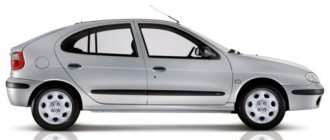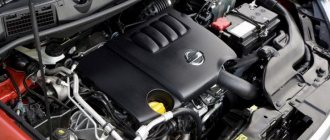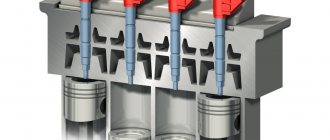Description of the motor
ATTENTION! A completely simple way to reduce fuel consumption has been found! Don't believe me? An auto mechanic with 15 years of experience also didn’t believe it until he tried it. And now he saves 35,000 rubles a year on gasoline! Read more"
The weight of this engine is small, many parts are aluminum. The combustion chamber is small in size, compact, and is a so-called “closed lid”. Due to the fact that the B5204T5 valves are located in a V-shape, air passes through the intake manifold as quickly as possible and in a larger volume. Therefore, the chamber is filled efficiently.
In the same way, the most efficient combustion of the fuel-air mixture is ensured. This is partly facilitated by the piston surfaces, manufactured according to the latest technological ideas. In addition, this engine design guarantees low sensitivity to detonation and good CO2 emissions. The engine fully complies with Euro-5 standards, the bolts do not contain harmful chromium 6+, and the bearings do not contain heavy lead.
The oval pistons of the engine are made of aluminum alloy. They are coated with graphite on the ends to soften friction and absorb noise. The rings are steel with an admixture of nitrogen or cast iron. For example, the oil scraper ring consists of three parts, each of which is steel. But the compression ring is cast iron.
The piston rod is hardened and held in place by lock washers. The shape of the pistons is not completely oval. They taper at the end. The elements are cooled through a special valve. It is made of steel and has a copper washer, which is responsible for preserving the oil and preventing leakage.
The turbine is made of durable material so that it does not deteriorate from high degrees (up to 1050°). It is fixed together with the bearing housing using a clamp.
The crankshaft is forged and supported by 6 bearings. The fifth of them also simultaneously performs the function of clutch locking. There is a spline on the front of the crankshaft that drives the oil pump. Another spline sets the position and direction of rotation of the drive gear.
The camshafts pass through the cylinder head. They rotate on six cages. These elements are made of cast iron. The cam lobes are specially reinforced to maintain their original properties when in contact with metal valve lifters.
It is noteworthy that there are gaps between the pushers and the protrusions. They are called valve clearances, designed to make up the difference resulting from overheating of metal surfaces.
Standard mechanical tappets are considered more efficient than hydraulic tappets because they provide less friction, better combustion and weigh less.
The motor is held on a bracket connected through the block head. The fixation takes place in three places at the same time: the spar protrusions, the gearbox supports and the body, thereby ensuring the best fastening of the power plant. Another support point is the lashings of the drive shaft, which allows the structure to absorb various vibrations.
Cylinder block and cylinder head
The block assembly consists of several parts:
- main part;
- middle section;
- oil pan.
The block sleeves are cast iron. They are durable, cast directly into the BC, but there is no way to replace them. Equally strong are the seats of the main bearings that reinforce the parts in the intermediate section.
There are lubrication passages in the main area of the cylinder block. They are also cast and are designed to supply oil to the bearings and cylinder head.
Despite the fact that the pallet is aluminum, it further strengthens the structure of the block. Here is the main channel through which lubricant is supplied to the pistons. The oil is sucked through a plastic tube. Inside the pan there are channels for easy movement of the lubricant and a sensor that monitors the lubricant level.
The block head is located at the top. Between the cylinder head and the cylinder head, the seal is carried out using a conventional cuff. But between the other zones - through liquid gaskets.
The cylinder head is produced by cold casting. This process takes a little longer than standard press casting, but the intake and exhaust ports, as well as the protective covers of the oil and water radiators, are combined into a single, durable structure. The head is divided into two parts:
- one is at the same time a cover for the valve device and the upper camshaft - there are channels for oil distribution here;
- the lower part has dampers and valves that do not require maintenance.
Volvo S60 T5. Love at first sight
Our acquaintance with the Volvo S60 T5 began on a gloomy autumn morning. It was drizzling. Leaden clouds, driven by a cold wind, put pressure on the psyche. I wanted to shoot back quickly - and go home
Oleg Kalaushin
Our acquaintance with the Volvo S60 T5 began on a gloomy autumn morning. It was drizzling. Leaden clouds, driven by a cold wind, put pressure on the psyche. I wanted to shoot back quickly and go home. However, the mood changed dramatically as soon as the “object” came into view. It was impossible not to fall in love with this car at first sight.
Volvo S60 T5 © Photo:
If the car had been painted a different color, our opinions on its appearance would probably have differed. But, my God, how red suits a sixty! Like boys seeing a naked woman for the first time, we devoured the “Swede” with our eyes.
She looked really impressive. Very similar to its older sister S80, but more elegant and graceful. A lot of epithets were spinning in my head that could be awarded to the beauty, but the flight of fantasy had to be stopped. After all, we were going to conduct a test, and not drag the young lady into a nearby hotel room.
Volvo S60 T5 © Photo:
Interest in the upcoming work was fueled by the T5 mule found on the trunk lid, next to the model index. Wow! We got the most powerful “sixties” offered by dealers today.
Under its hood, on a rod mounted in a spacer between the front pillars, for the time being, a 250-horsepower turbocharged engine dozed, like in a hammock. Such an intricate way of attaching it to the body was invented by Volvo to minimize the vibration transmitted by the five-cylinder engine to the body both at idle and while driving.
It should be noted that the game was worth the trouble, since you can only determine whether the engine is running or not by looking at the tachometer needle. Vibration in the cabin is practically not felt. Only a very sophisticated nature will be able to notice it, and only on condition that the audio system is turned off at that moment.
But I don’t want to “stop the music” at all. The last time I personally heard sound of this quality was in the car of a friend who had spent 4 thousand dollars on the equipment. And here such frequencies are produced by the standard CD radio. Amazing. Not a car, but a philharmonic on wheels. So we would sit, listen to a CD and bask in the warm air currents “flowing” from a powerful heater. By the way, its control allows you to select the optimal temperature for the driver and front passenger separately. Rear passengers are not deprived of heat either, but for them the choice of climate is common.
In general, the entire internal space of the “sixty” is permeated with care for people. The ergonomics of the command post are amazing. When you sit behind the wheel, you can provide yourself with very comfortable conditions. Not only are the seat adjustments electric, but the steering wheel can not only be set at an angle optimal for viewing the instrument panel, but also moved or moved back. The last adjustment, by the way, is very useful, since many people are annoyed by the steering wheel hanging over their acquired beer belly.
When removed before a long journey or in hot weather, the jacket can be hung on the hook attached to the headrest of the right front seat. On the road, removing a business card holder, wallet or notebook from your pocket will not be difficult.
You won't have to fish your cell phone out of your clothes. It is enough to remove the SIM card from it and insert it into the slot on the center console. After this, you dial the required number on the keyboard located there on the console, and you are in touch. If they call you, then in order to answer, there is no need to take your hands off the steering wheel. You press a button and have a conversation in loudspeaker mode, and the interlocutor’s voice will flow from a speaker installed in the headrest, near the left ear.
There is also a remote tube in the armrest of the front seats - for those who like to keep things secret. Its cord is enough to ensure the confidentiality of a conversation when sitting in any of the five seats.
Volvo S60 T5 © Photo:
Supporting the concept of a family car, Volvo has also taken care of the youngest passengers. The power window keys can be locked from the driver's seat so that the child does not have to practice catching the wind with his hands during a long journey. Well, if you do allow your child to “train” the glass, rest assured that it will not harm him. The rising glass, encountering the slightest resistance, will instantly lower. In addition, the armrest of the rear row of seats can be converted into a comfortable child seat equipped with a three-point seat belt in the blink of an eye.
While we are talking about seat belts, we note that the driver can sit in the car for as long as he likes without wearing a seat belt, even with the engine running. But as soon as you hit the road, the annoying bell will begin to get on your nerves and will not calm down until the “careless rider” comes to his senses. Having resisted the annoying offer for a long time, I finally buckled up. This, you see, is better than trying on a stretcher for the tibia later.
Although, it seems to us, it is almost impossible to get serious injuries here in the event of a traffic accident, since the car is equipped as standard with six airbags, inertial belts with preload and a tension limiter, as well as active front seat head restraints. In addition, the front and rear power structures of the body have been significantly improved.
Active safety is also excellent. The DSTC system provides the car with excellent directional stability in almost any situation. When necessary, the system brakes one or more wheels, prevents the drive wheels from turning, and makes the necessary adjustments to the operation of the ABS. Moreover, if on previous models DSTC came into effect only upon reaching 40 km/h, then on the S60 it works throughout the entire speed range.
Even at 240 km/h you feel calm and peaceful in the car. The S60 holds the road so tenaciously that it seems as if only a magnitude 12 earthquake could knock it off the “true path.”
The designers achieved this not only by introducing electronics, but also by unifying the S60 with its older sister. Almost the entire suspension migrated here from the S80. Minor changes affected only the levers. Hence the widest vehicle track in the class: 1563 mm at the front wheels and 1560 at the rear. As a result, a fully equipped 1,427-kilogram car practically does not roll when cornering, does not nosedive when braking, and does not squat on the rear axle during sharp acceleration.
And believe me, it’s possible to go to the point at T5. It takes only 7 seconds to accelerate the car to 100 km/h. The sensations are comparable to those you experience when an airplane takes off. It takes your breath away throughout the run and only lets you go when you reach maximum speed.
By the way, only during lightning-fast throws in space does the engine begin to be heard in the cabin. However, his baritone is so pleasant that sometimes you stomp on the pedal just to listen to his singing.
True, you will conquer the seven-second mark only if you learn not to mix up gears. You may have to get used to the elasticity of the “joystick” rising above the central tunnel.
Why? Yes, because it’s very difficult to catch “neutral” if you’re not used to it. We, brought up in the best traditions of the domestic automobile industry and knowing firsthand that in the neutral position the lever should dangle like a pencil in a glass, for some time it was not clear where to look for this “neutral”. The rocker strokes are short, and in almost any position the lever had the same play. But we figured it out a little later.
You should not perceive the Volvo S60 T5 as a car designed exclusively for dynamic sports driving at maximum engine speeds. The high torque of 330 Nm already at 2500 min-1 allows you to move in the city crowd almost in third gear. Sometimes you get the impression that you are driving a car with an automatic transmission, only instead of using the brake pedal you need to smoothly release the clutch pedal. True, this pedal, in our opinion, has an unreasonably long stroke.
The sun that appeared briefly revealed one peculiarity: a cream-colored dashboard was quite clearly projected onto the windshield, sometimes interfering with a clear perception of the road situation. Otherwise, the view from the driver’s seat can be considered impeccable, because even maneuvering in reverse can only be done using the mirrors, but mainly using the outside ones.
The fact is that for the sake of aerodynamics and elegance, the rear window of the S60 is too inclined. In this regard, it is almost impossible to correctly determine where the rear of the car ends by looking only in the interior mirror. The headrests of the rear row of seats also interfere with orientation, hiding the edge of the trunk from your eyes.
The luggage compartment of the sixty is very roomy. The volume can also be increased by folding the rear seat backs together or separately. If desired, the trunk is fenced off with a lid of a shallow compartment for various small things. The lid is fixed in a vertical position, and small bags or even a “diplomat” can be attached to it.
But transporting something large will not be easy. For example, it is unlikely that you will be able to squeeze a TV through a small opening.
Having driven the car for almost a whole working day, none of us experienced even a hint of fatigue. The car is comfortable, functional and, despite its power, not so gluttonous. The trip computer display showed quite acceptable average and instantaneous fuel consumption.
Subsequently, after recalculating its readings, we found that fuel consumption coincides with the figures declared by the manufacturer and amounts to 9.3 liters per 100 km on a combined cycle. Agree, for a “sports-family” sedan the appetite is quite acceptable.
There are more economical versions. However, saving lies not only in frugality, but also in the ability to choose the right product. What are we talking about? And to the fact that even the weakest of the three officially supplied to Russia, the S60 - with a 170-horsepower engine - needs an average of 8.7 liters of gasoline per 100 km. So is it worth being stingy? Moreover, a person who found 33 thousand dollars to buy the cheapest “sixty”, as it seems to us, can easily carve out another 12 thousand from his budget and take the super-modified T5. Love like the queen.
Technical specifications Volvo S60 T5
Body – 4-door monocoque Number of seats, persons. – 5 Curb weight, kg – 1427 Dimensions (length/width/height), mm – 4580/1800/1430 Wheelbase, mm – 2720 Maximum speed, km/h – 250 Acceleration time to 100 km/h, s – 6.8 Control fuel consumption, l/100 km (combined cycle) - 9.3 Engine: - type - 5-cylinder, in-line - displacement, cm3 - 2319 - power, hp at min-1 - 250/5200 - torque, Nm at min-1 - 330/2500 - power system - distributed injection Transmission - 5-speed, manual. Tire size – 225/45R17 Wheel suspension: – front – McPherson – rear – multi-link Brakes: – front – disc, ventilated – rear – disc Steering – with hydraulic booster Price, $ – 45,000
The editors recommend:
“Halogen” Osram Night Breaker 200: how to improve the headlights without disturbing anything.
How to return unpainted body plastic to black?
How to defeat corrosion? An effective way to remove rust yourself
Discussion Cancel
I want to receive the most interesting articles
Intake manifold: flaps again
At first, the manifold of the Volvo D5 engine (and its derivative versions) did not have swirl flaps. They have appeared since 2006. And the problems with them are classic: the dampers jam due to soot and begin to open poorly. Because of this, the holes in the plastic drive rod for the servo drive hinges and the damper axles are broken. As a result, the thrust jumps off and the engine begins to become very dull. The traction itself costs a penny; even the owner of the car can change it.
It’s worse if the hole in the valve axis is broken and gases along with oil begin to seep out from there. In the most expensive cases, the gears of the servo drive are cut off or one of the dampers breaks off and flies into the motor.
Modernization: swap, decarbonization
The B5204T5 engine is two-liter, so its power is somewhat limited. This is the reason that many Volvo drivers decide to replace it with the more powerful 2.3-liter B5234T. In addition, this power unit has:
- forged pistons;
- internal elements identical to B5204T5, except for the crankshaft and connecting rods.
The swap procedure is usually accompanied by decoking of the cylinder head piston rings, block, and intake manifold in order to remove stagnant carbon deposits. This is done using a carb cleaner. As a result, the mobility of the rings will increase, the volume of the combustion chamber will increase, and oil consumption will decrease. In addition, this procedure will eliminate the appearance of scoring on the cylinder walls, increase the power of the unit, and significantly increase the time until the next overhaul.
| Fieldier | Is it possible on a Volvo s80 2000? 2.0 turbo, engine B5204T4 163hp. install the B5204T5 180hp engine. There is such an engine in very good condition, but in my B5204T4 the piston pierced the block. I want to change it. Are there any nuances when replacing? Attachments keep it from the old engine? B5204T5 2002. And if I may add, what is the difference between the B5204T5 (180 hp) and the B5204T3 (226 hp). I want to know if it is possible to flash the ECU with firmware from B5204T3 (226 hp) to get 226 hp. Or do you need to change something else regarding the hardware? |
| Vasya | Of course it is possible. |
| Denis | Here is a list of planned modifications: Turbo 16T ($300-$350) (or hybrid)_hopefully it won’t be more expensive S60R injectors (green) ($250) Full exhaust on the 63rd pipe ($400-$700)_approximate cost (Item. laguna11 recommended the 63rd, initially I was thinking the 76th, but for my wishes the 63rd should be more than enough) Intake ($250-$300)_approximate cost Calsonic intercooler from GTR (as I understand it is the most optimal) ($150-$200 ) (but now I'm thinking maybe a Polish fmic?) Fuel pump ($150) (may not be needed) Turbine control valve (TCV) (IPD, Snabb, Phuzzy Motorsports and any) ($50-$100) (may not be needed) will be needed) software (setup) ($300-$400)_but here it can probably be much more expensive. I am also concerned about the possibility of detonation (cf. 9.5:1). Is there an option to choose a thicker gasket? And of course, where to set all this up? Oh, and also, do you need to register the injectors? Or did you remove and install? |
| Sergey99 | I agree that for 300 hp 63 exhaust pipes are quite enough. |
| Eric | I would just buy a 2.3 engine (8.5 s.z.) with blue injectors included (for 391cc), check all the injectors, clean the spills on the stand, choose 5 good ones. (if they pour in different ways, you will catch detonation - you will kill the engine) (HZ at prices today, but not expensive) Buy new spark plugs that are a number colder (for the heat and boost over 1.3 bar), for the winter you can use both regular and new coils . ($230) New correct fuel pump - $200 + $60 installation. (this is if you can’t turn it on yourself) (if the old one gives crappy pressure - similarly - Denton and “Palyamausya” motor) |
| Torca | I don’t believe that with the list of its modifications, with forces, brains, turbos, etc., 76 pipes are too much for him. At 2.4T in stock, replacing the cat with a 76 pipe already gave results, even without other additives. And in these subs, now there is one with 2.4 atmo, by the way, the exhaust is an order of magnitude more complex. So there is a moot point here, when in the ES60 there is simply a corrugation and a pipe with one bend, and when here the original exhaust of the sub is smeared on both sides along the bottom, maybe in that situation there are some technical difficulties in execution. |











